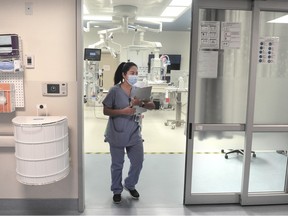The minimum ratios will be rolled out by the fall, says the Health Ministry

Article content
B.C. has established new nurse-to-patient ratios — the first of their kind in Canada — in certain hospital settings, in a bid to retain and recruit nurses amid a staffing shortage.
Health Minister Adrian Dix said B.C. has led Canada “in just about every category” in the recruitment of nurses, but a rising population and health emergencies have put persistent pressure on health care across the province.
Advertisement 2
Article content
Article content
“We’ve got to take action to make sure that this is the best place in the world to be a nurse,” Dix said on Friday. “That’s our joint commitment, and that’s what this announcement is about today.”
Dix said setting the standards would improve patient care in hospitals, reduce the risk of burn out for nurses, and strengthen B.C.’s health workforce. It is part of a provincial commitment made last year during contract negotiations with the B.C. Nurses’ Union.
The minimum nurse-to-patient ratios, which are expected to be rolled out by the fall, will be implemented in six health-care settings in B.C. hospitals, including:
• General medical and surgical wards: one nurse to four patients.
• Palliative care units: one nurse to three patients.
• Rehabilitation units: One nurse to five patients on day/evening shifts; one nurse to seven patients on night shifts.
• Special care units: one nurse to three patients.
• High-acuity units: One nurse to two patients.
• Intensive care units: One nurse to one patient.
Nurse-to-patient ratios are used in Australia and California, but not in Canada until now. Dix said no other jurisdiction in the world has a minimum ratio that applies at all times.
Article content
Advertisement 3
Article content
Dix said the work to implement the ratios will begin immediately, and the Health Ministry will work with the nurses’ union to establish more minimum ratios in other hospital settings as well as in long-term care and community settings.
Adriane Gear, president of the nurses union, said the announcement is a “bold step” for government. “We know that minimum nurse-to-patient ratios improve job satisfaction, create safe and healthy workplaces for nurses and improve patient care,” she said in a statement.
Jim Gould, interim CEO of the union, called the minimum nurse-to-patient ratios “the single most-important policy solution available” to address the staffing shortage in the profession.
To help support the staffing required by the new standards, the province said it will be spending $237 million to help retain and recruit nurses.
This includes $169.5 million in one-time funding for the expansion of provincewide rural retention incentives and signing bonuses in rural and remote communities and for difficult-to-fill vacancies in urban communities, which will be available as of April 1.
Advertisement 4
Article content
Eligible nurses who fill high-needs vacancies in northern B.C. could receive as much as $30,000 signing bonus, $20,000 in other rural and remote areas, and as much as $15,000 in metro area, said the ministry.
The nurses will be required to sign a two-year commitment.
It will also spend $68.1 million in one-time funding towards training and licensing nurses, including expanding the program to bring in internationally educated nurses and nursing student tuition credits and bursaries.
Last year, B.C. had 6,567 newly-registered nurses join the workforce, said the ministry.
In a statement by the Hospital Employees’ Union, spokeswoman Meena Brisard says the province should extend the rural incentives and staffing model to other members of B.C.’s health-care system.
“Only by expanding these investments in improving working and caring conditions across health care can we better ensure all British Columbians have access to high quality care in the future,” Brisard said.
With files from Canadian Press
Recommended from Editorial
Article content





